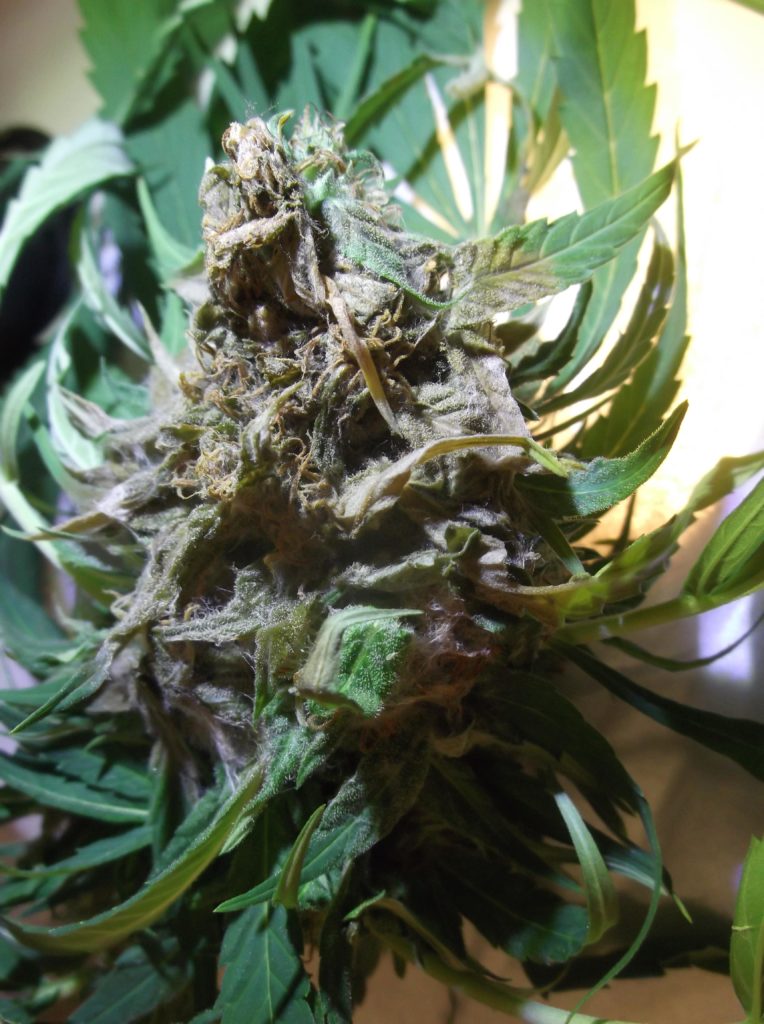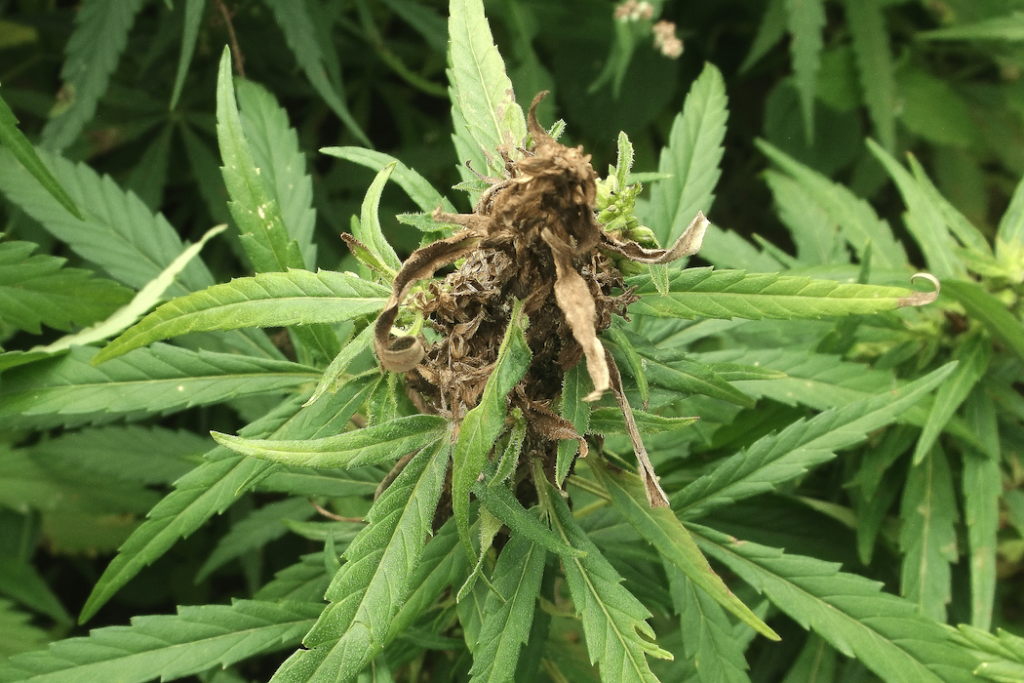An understanding of the diseases that affect hemp is being rediscovered as farmers across the U.S. have cultivated the crop in recent years, planting myriad varieties in widely varying conditions. Meanwhile, research on diseases impacting hemp and methods of controlling them are still in their early stages after the decades-long prohibition of the plant.
New Threats in New Regions
Pathogenic threats to hemp are widespread, but still not fully understood in some cases. Joseph Ramahi, Chief Science Officer for California-based Cultivaris Hemp, recently drew attention to a potentially serious problem for cannabis growers: Hop Latent Viroid (HpLV). The disease, first announced in California in 2019, apparently originated with hops; however, it can also infect cannabis, a relative of hops.
Ramahi told Marijuana Business Daily that HpLV can cause stunted growth as well as a lack of trichomes, cannabinoids, and terpenes in hemp. He added that HpLV testing is “still not common practice” in the cannabis industry and noted that the disease’s spread in the U.S. is “an unfortunate byproduct of the legalization wave after 2012,” when cannabis plants from the West Coast were introduced across the country.
Another case in point regarding the rapid and still understudied spread of hemp pathogens is a report from North Carolina State University (NCSU), published in late 2020. It is reportedly one of the first modern studies on hemp-related diseases in the southeastern U.S. “Interestingly, diseases that are frequently reported in other hemp-producing regions in the western U.S. or worldwide, such as gray mold or powdery mildew, were not prominent diseases in our study,” Lindsey Thiessen, a plant pathologist at NCSU, told The American Phytopathological Society in January. Thiessen and her colleagues observed 16 different diseases as they evaluated hemp samples in North Carolina and acknowledged that “little research” on hemp has been conducted recently in the U.S.
Shattering Myths About Hemp and Disease
This new research on hemp diseases is exploding some of the long-established myths about the plant, particularly when it comes to hemp’s reputation as being disease and pest-resistant. “Coming in as a complete novice in this field, that was the first thing I encountered in the [hemp] literature; that ‘this is a great crop because it has no pest or disease problems.’ Well, we shattered that on day one, that’s absolutely wrong,” Gary Bergstrom, Professor of Plant Pathology at Cornell University, told Hemp Benchmarks.
Bergstrom, who specializes in studying row crops like corn, wheat, and soy, has been working on hemp issues with agriculture extension programs and other researchers in New York State for the past four years. He noted that hemp, especially the varieties grown for CBD, has a number of vulnerabilities to pests and disease. “What we’re involved in now,” he added, “is trying to determine what those are and … which are the really important ones that we should invest research efforts, in trying to develop controls.”
Knowing Your Adversary
Bergstrom said the majority of diseases affecting hemp are fungal and come from the same classes of organisms that cause disease in other crops. Some of the more common and prevalent hemp diseases currently seen across the U.S., according to Bergstrom and his colleagues at Cornell, include:
- White Mold: Considered a significant threat to hemp, the fungus also attacks many legumes and vegetable crops. “It has a host range of over 400 plants,” said Bergstrom.

- Pythium: An organism that is like a fungus but is actually a water mold, Pythium produces “swimming spores” that travel in films of water and infect the roots and seedlings of many plants, leading to seed rot and seedling blight. Hemp, Bergstrom noted, is particularly susceptible to Pythium.

Pythium damping-off of hemp seedlings. Photo by Kevin Myers, Cornell University 
Pythium wilt of adult hemp plants. Photo by Kevin Myers, Cornell University
- Botrytis: Also known as Gray Mold, Botrytis flourishes in humid conditions with poor air flow. It causes a “profuse gray mold on [hemp] floral tissues around the time you’d want to be harvesting,” said Bergstrom.

Close-up of gray mold on hemp flowers. Photo by Jennifer Starr, Cornell University 
Gray mold (Botrytis) on hemp flowers. Photo by Jennifer Starr, Cornell University
That trio of diseases, however, are only the tip of the pathogenic iceberg when it comes to the ailments that can affect hemp crops. There is also a wide variety of leaf blights, mildews, and rusts that can damage hemp. Bergstrom said he is troubled by a fungal genus called Fusarium, which usually attacks hemp buds at the end of the growing season.

“I’m particularly concerned about this because [Fusarium] produces dangerous toxins,” he said. “We have been recovering levels of one toxin, deoxynivalenol, finding it as a contaminant in hemp grain … and in floral tissues as well.” The U.S. Food and Drug Administration currently advises that there be no more than one part per million of deoxynivalenol, also known as Vomitoxin, in finished food products such as wheat and flour meant for human consumption.
Each Disease ‘Has its Own Story’
Good agricultural practices are the key to controlling hemp-related diseases. However, Bergstrom noted, some diseases specialize in attacking hemp’s root system while others focus on hemp leaves – and nearly all have their own unique methods of spreading – which in turn require specifically-focused preventative strategies.
“That’s the annoying thing; each one has its own story,” he said. “The epidemiology is so variable. In the case of White Mold, it produces a resistant structure that can survive in the soil for a number of years, and … will probably contaminate the soil debris. It will be in whatever you don’t harvest and take into the barn, what’s left on the soil surface.” Some fungal spores, meanwhile, can be spread by splashing rain from plant debris that reaches a new hemp crop, while others can become airborne and travel great distances.
The IR-4 Project
Future methods of combating these hemp diseases may vary widely; from stricter preventive measures to regional quarantines. Given hemp’s still-uncertain regulatory issues, there are only a limited number of pesticides approved for use on hemp. That might be changing, however. Bergstrom points to The IR-4 Project, a decades-old partnership between the U.S. Department of Agriculture, the Environmental Protection Agency, and parts of the U.S. agricultural and commodity sector. According to its mission statement, the project facilitates the “regulatory approval of sustainable pest management technology for specialty crops and specialty uses to promote public wellbeing.”
The program, said Bergstrom, “tries to supply funds to encourage minor-use labels for agricultural chemicals. For instance, IR-4 is supporting research between Cornell, Virginia Tech, and North Dakota State universities … to develop seed fungicides specifically for hemp; for things like Pythium control.”
More Full-Time Research Needed
Bergstrom believes that research on hemp pathogens also needs greater attention if it is to succeed. “There are a lot of us doing this as a small part of our appointments,” he said, referring to his fellow researchers. “Relatively few people are doing it full-time. That probably has to change. But collectively, and one of the good things with a new crop like this, we’re generously sharing data across state borders. It’s a very nice network of folks.”
He is also seeing more interest from hemp businesses into this line of academic study. “There’s not a lot of cash around for grants for this kind of investigative work,” he added, “but there’s industry support, and hopefully more government support. I’m optimistic that it’s going to happen. Exciting things are coming down the pike.”
Other Diseases Affecting Hemp

Sporulation on the lower leaf surface of hemp by the water mold which causes downy mildew. Photo by Gary Bergstrom, Cornell University 
Downy mildew symptoms on the upper surface of hemp leaves. Photo by Gary Bergstrom, Cornell University

Bipolaris leaf spot, also known as hemp leaf spot. Photo by Gary Bergstrom, Cornell University 
Septoria leaf spot of hemp. Photo by Jennifer Starr, Cornell University


